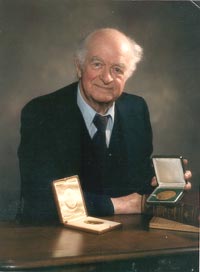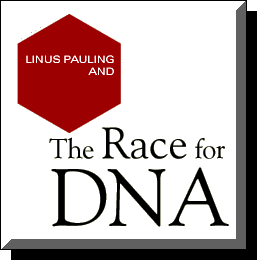In the first term of his seminal contributions to science in the 1920s Linus Carl Pauling brought quantum physics and his powerful visual imagination into chemistry.
Pauling graduated from Oregon State University in 1922 and went on to attend the California Institute of Technology in Pasadena, California, where he continued his studies in chemistry, physics and mathematics and earned a Ph.D. in 1925.
Pauling was distinguished by an appointment as National Research Fellow and was awarded a Guggenheim Fellowship for study in Europe. He spent most of his one-and-a-half years abroad at the Arnold Sommerfield Institute for Theoretical Physics in Munich and also spent a few months at Niels Bohr Institute in Copenhagen and another institution in Zurich. Pauling then returned to California and began his long career as a professor and researcher at Caltech.
Pauling was one of the first American chemists to master the technology of x-ray diffraction. This is the tool with which the distances and angles of atomic bonds in the three dimensional structure of crystals and molecules are determined; it is the tool that primarily brought on the revolution in the life sciences that we today call molecular biology.
Pauling's development of the coordination theory for complex substances helped to create the field of crystal chemistry. This theory helped to bring x-ray diffraction into analysis of the structure of organic molecules.
Pauling became interested in electron diffraction and he used this powerful tool along with x-ray diffraction in his determination of the structure of the large molecules of life.
As x-ray analyses and electron diffraction gave him experimental tools for exploring the structure of molecules, so his study of Quantum Mechanics in collaboration with Albert Einstein provided Pauling with a theoretical tool. With his battery of tools he helped to bring about the reconstruction of the foundation of the science of chemistry, thus creating our modern chemistry.
The new chemistry sees the bonds between and among the atoms of a molecule as established by the action of electrons. Pauling was the principal organizer, generalizer, and system builder. His great work, The Nature of the Chemical Bond, is a landmark in the history of science.
By the middle 1930s Pauling was studying the hemoglobin molecule and the vital function of its property of combining reversibly with the oxygen molecule. Interest in hemoglobin led naturally to a more general interest in proteins.
Pauling published a paper, General Theory of Protein Structure, which suggested that the polypeptide chain of each protein is coiled and folded into a specific configuration.
Pauling's first paper, A Theory of the Structure and Process of Formation of Antibodies, appeared in 1940.
Pauling was awarded the Presidential Medal for Merit for his work in finding an artificial substitute for blood serum.
In 1949 Pauling established that sickle-cell anemia was a molecular disease caused by an abnormal hemoglobin molecule and the abnormal hemoglobin was caused by just a single amino acid anomaly in one of the polypeptide chains.
While a professor at Oxford in 1948, Pauling discovered the alpha helix and this structure was soon verified experimentally. It is generally known among his peers that, by this, he discovered the DNA genetic molecule and its three-dimensional helical structure, although others received official recognition by proving the discovery with equipment then not available to Dr. Pauling.
Pauling is the only person in history to have won two unshared Nobel Prizes; one for chemistry and the other the Peace Prize for his work with the effect on populations of the neutron flux and carbon 14 produced by atmospheric atomic testing.
Pauling founded the Linus Pauling Institute of Science and Medicine in 1973, where he continued his research into nutrition, established the science of orthomolecular medicine, and received great notice for his work with ascorbic acid (vitamin C) and its related compounds.
Pauling has published a number of books written for the lay reader including Vitamin C and the Common Cold, Cancer and Vitamin C: A Discussion of the Nature, Causes, Prevention, and Treatment of Cancer With Special Reference to the Value of Vitamin C, and How to Live Longer and Feel Better.
Pauling's work at the Linus Pauling Institute, in collaboration with his colleagues including those at the University of Hamburg who had been studying a newly discovered lipoprotein, lipoprotein (a) ("Lp(a)"), resulted in the discovery of a combination of ascorbate and amino acids which has been shown to prevent and reverse atherosclerosis and its associated heart attacks, strokes and peripheral vascular disease. Pauling issued a general plea to the scientific industry to eradicate heart disease from the earth through the use of these discoveries.
THE SCIENTIFIC ACHIEVEMENTS OF
DR. LINUS C. PAULING
“Science cannot be stopped. Man will gather knowledge no matter what the consequences – and we cannot predict what they will be. Science will go on – whether we are pessimistic, or are optimistic, as I am. I know that great, interesting, and valuable discoveries can be made and will be made . . . But I know also that still more interesting discoveries will be made that I have not the imagination to describe – and I am awaiting them, full of curiosity and enthusiasm.”
~ Linus Pauling, 1947
Yale University Lecture
Home | Products | Online Store | The Pauling Therapy | Linus Pauling | Testimonials | Policies | Contact
Visit These Outstanding OSU
Linus Pauling Exhibits
(click on the image buttons below)
LINUS PAULING: Nature of the Universe

 | ||||||
Linus Pauling, Ph.D.
© By Peter Barry Chowka


702-876-5805
LINUS PAULING: Unified Theory
of Cardiovascular Disease
Made in the U.S.A. • Copyright © 2008 • All Rights Reserved.
Tower Laboratories Corporation • 3395 S. Jones Blvd., #349 • North Las Vegas, NV 89146
(702) 876-5805
Disclaimer: These statements have not been evaluated by the U.S. Food and Drug Administration (FDA). This product is not intended to diagnose, treat, cure or prevent any disease. Tower Laboratories Corporation does not make any health or medical claims for its products. Tower is not responsible for independent third parties who may otherwise represent the efficacy of Tower products. These individuals are not Tower agents and do not have permission to do so. Testimonials are believed to be within the range of typical consumer responses, though your results may differ. Unsatisfactory products sold in the United States of America may be returned for a full refund within 60 days of the original ship date.
